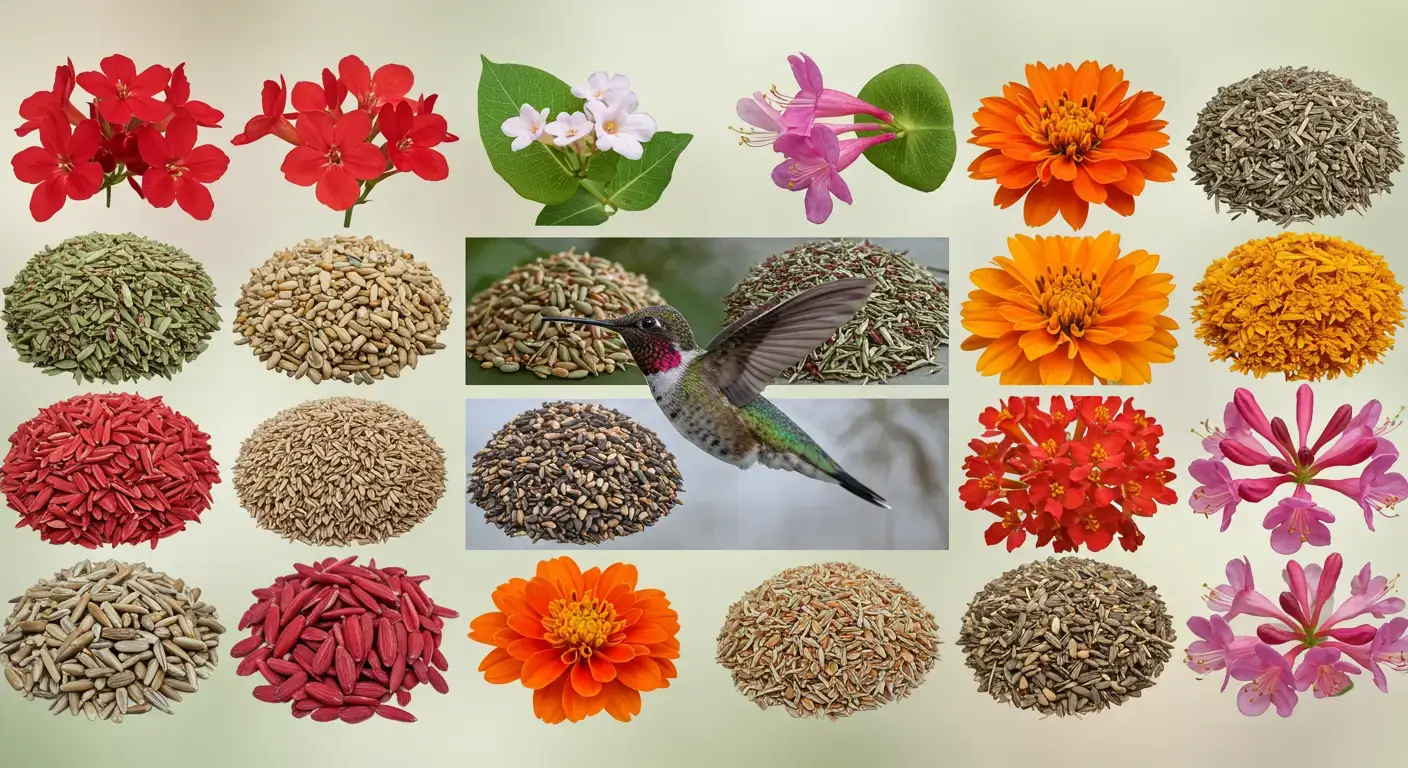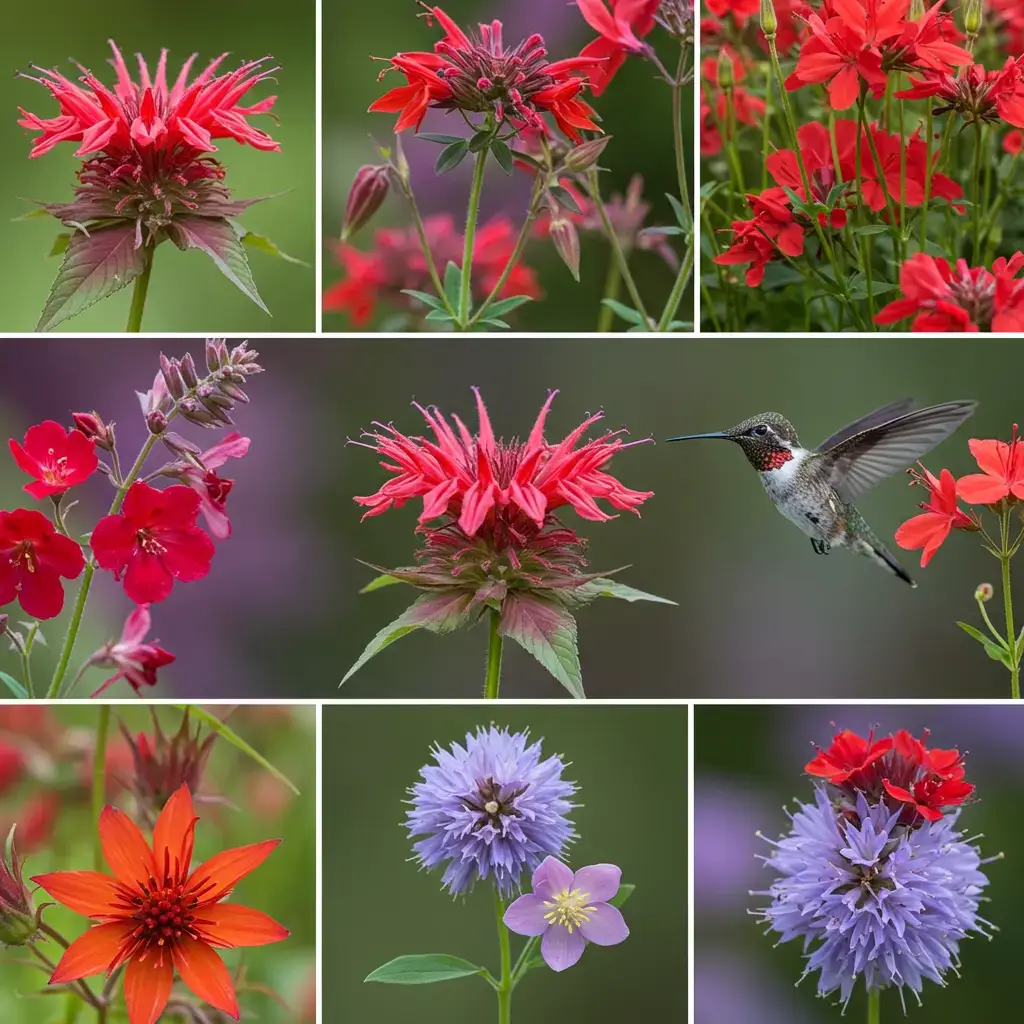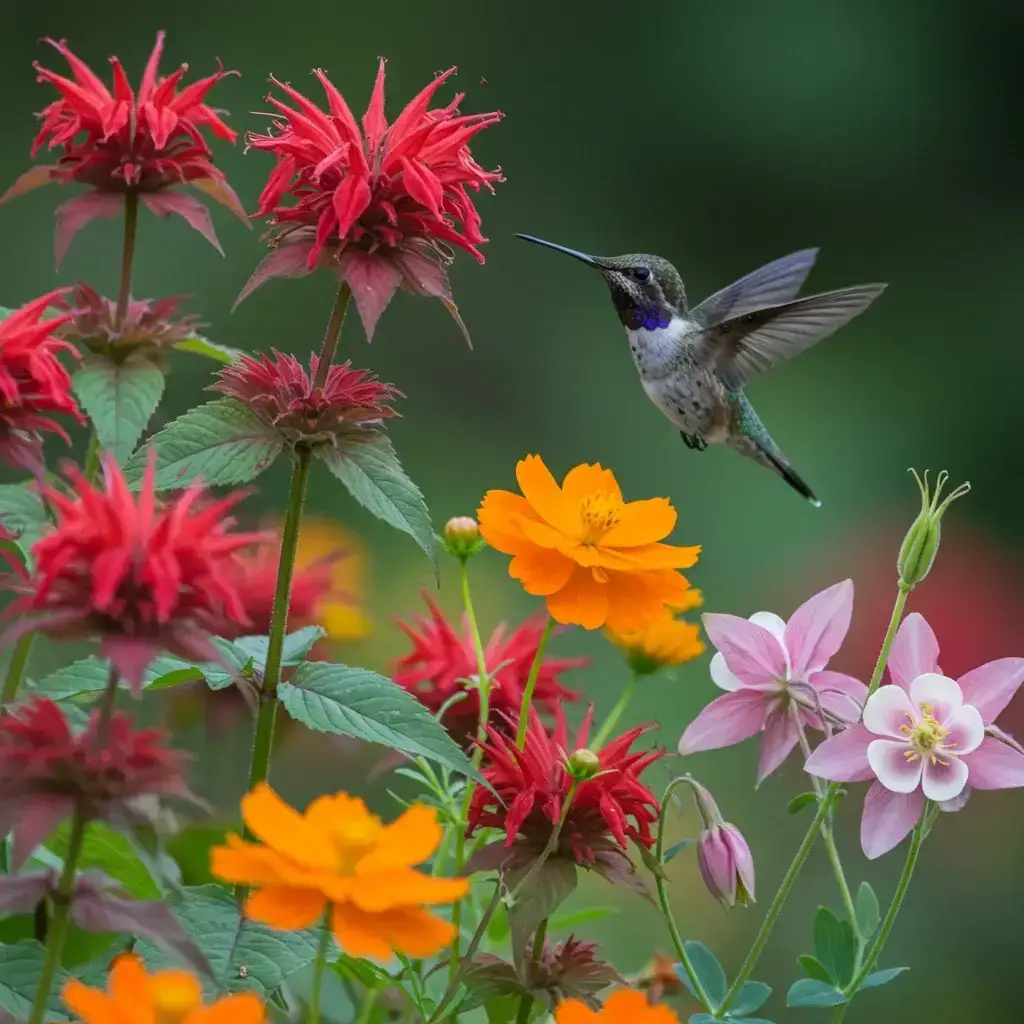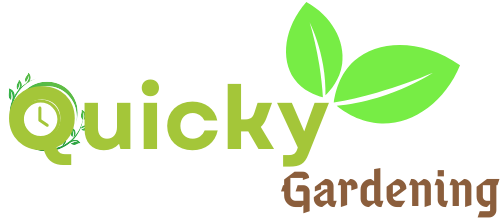Creating a vibrant garden that attracts hummingbirds is a rewarding experience for any gardener. These tiny, iridescent creatures bring life and movement to outdoor spaces while serving as important pollinators. Growing hummingbird flower seeds not only saves money but also allows you to cultivate a wider variety of plants than what might be available as nursery starts. This comprehensive guide will explore the best hummingbird flower seeds to plant, how to grow them successfully, and how to create the perfect habitat that will keep these aerial acrobats returning season after season.
Choosing the Best Hummingbird Flower Seeds for Your Garden
Hummingbirds have specific preferences when it comes to the flowers they visit. Understanding these preferences is key to creating a garden that will consistently attract these beautiful birds.
Color Attractions: Why Red and Bright Hummingbird Flower Seeds Matter
Hummingbirds have excellent color vision but a poor sense of smell. Their visual system is particularly sensitive to the red-orange spectrum, which explains why they’re so attracted to vibrant blooms in these hues. While red flowers are classic hummingbird attractors, these birds also visit flowers in bright orange, deep pink, and purple.
Research has shown that hummingbirds can see colors we cannot, including ultraviolet light. Their color preferences evolved alongside the flowers that provide their nectar, creating a mutually beneficial relationship. When selecting hummingbird flower seeds, prioritize varieties with bright, bold colors—especially those with red tubular blooms, which are almost guaranteed to attract attention.
Flower Shapes That Hummingbirds Love: Tubular and Trumpet Flower Seeds
The shape of a flower is just as important as its color when attracting hummingbirds. These birds have specialized long, thin bills and extendable, forked tongues perfectly adapted for reaching deep into tubular flowers. The ideal hummingbird flower seeds will produce blooms with the following characteristics:
- Tubular or trumpet shape
- Downward-facing or horizontal orientation
- Sufficient depth to hold nectar
- Strong enough to support the weight of a hovering bird
Flowers with these characteristics provide exclusive access to hummingbirds while often excluding insects and other birds that can’t reach the nectar. Look for hummingbird flower seeds that produce these shapes, such as salvias, penstemons, and columbines.
Nectar Production: The Fuel That Drives Hummingbird Visits
Hummingbirds have the highest metabolism of any animal except insects. They must consume more than their body weight in nectar each day and can visit hundreds of flowers from sunrise to sunset. The best hummingbird flower seeds will produce plants with:
- High nectar volume
- Proper sugar concentration (typically 20-25%)
- Extended blooming periods
- Sequential flowering throughout the season
Plants like bee balm (Monarda), cardinal flower (Lobelia cardinalis), and trumpet vine (Campsis radicans) are known for their abundant nectar production, making them staples in any hummingbird garden started from flower seeds.
Bloom Timing: Creating a Season-Long Feeding Station with Hummingbird Flowers
To maintain a hummingbird-friendly garden throughout the growing season, plan for continuous blooms from early spring until fall migration. This requires thoughtful selection of hummingbird flower seeds with different blooming periods:
- Early season: Columbine, coral bells
- Mid-season: Bee balm, salvia, penstemon
- Late season: Cardinal flower, zinnia, morning glory
By staggering bloom times, you create a reliable nectar corridor that will keep hummingbirds returning to your garden throughout their active period. Strategic planting of hummingbird flower seeds with varied maturation rates ensures your garden remains a constant food source.
Read More
Top Annual Hummingbird Flower Seeds for Fast Results

Annual flowers grow, bloom, and complete their life cycle in a single season. They typically provide quick results and abundant blooms, making them excellent choices for first-year hummingbird gardens started from seed.
Zinnia Seeds: Easy-to-Grow Hummingbird Flower Seeds
Zinnias are among the most reliable and easy-to-grow annual flowers for hummingbirds. These versatile plants bloom prolifically from summer until frost and come in a wide range of heights, colors, and flower forms.
For hummingbirds, the single-flower varieties with exposed central disks provide the best nectar access. Look for:
- Zinnia elegans ‘Scarlet Flame’ – brilliant red blooms that hummingbirds can’t resist
- Zinnia ‘Peppermint Stick’ – multicolored flowers that bloom abundantly
- Zinnia ‘Queen Red Lime’ – unusual coloration that still attracts hummingbirds
Zinnia flower seeds can be directly sown after the last frost and will typically flower within 60-70 days. They prefer full sun and moderate water, making them adaptable to most garden conditions.
Salvia Seeds: Versatile Hummingbird Flower Options
Annual salvias produce some of the most nectar-rich flowers for hummingbirds and come in a wide variety of heights and colors. Their tubular blooms are perfectly shaped for hummingbird feeding.
Top annual salvia flower seeds include:
- Salvia coccinea (Texas Sage) – heat-tolerant with bright red blooms
- Salvia splendens (Scarlet Sage) – classic bright red flowers on compact plants
- Salvia farinacea (Mealy Cup Sage) – drought-tolerant with blue-purple spikes
Start salvia seeds indoors 6-8 weeks before the last frost for earlier blooms, or direct sow when soil temperatures warm. Most will flower within 8-10 weeks and continue blooming until frost with regular deadheading.
Morning Glory Seeds: Climbing Flowers for Hummingbirds
Morning glories provide vertical interest and can cover fences, trellises, or arbors with trumpet-shaped flowers that hummingbirds love. These fast-growing vines produce abundant blooms throughout summer and into fall.
Best morning glory flower seeds for hummingbirds include:
- Ipomoea ‘Scarlett O’Hara’ – crimson-red flowers that open daily
- Ipomoea ‘Heavenly Blue’ – sky-blue trumpets that attract hummingbirds despite their color
- Ipomoea ‘Grandpa Ott’s’ – deep purple flowers with magenta stars
Before planting, soak morning glory seeds overnight or nick the hard seed coat to improve germination. Direct sow after all danger of frost has passed and provide sturdy support for these vigorous climbers.
Other Must-Have Annual Hummingbird Flower Seeds (Cosmos, Nasturtium, Cleome)
Several other annual flowers grown from seed provide excellent hummingbird nectar sources:
Cosmos produce airy, daisy-like flowers that bloom profusely in summer. The bright colors and easily accessible nectar make them hummingbird favorites. Try Cosmos sulphureus for orange-red varieties specifically attractive to hummingbirds.
Nasturtiums offer both flowers and edible leaves. Their funnel-shaped blooms in reds, oranges, and yellows provide nectar, while their sprawling or climbing habit adds versatility to the garden. ‘Empress of India’ features dark foliage with bright red flowers perfect for hummingbirds.
Cleome (Spider Flower) produces tall stalks topped with unique flowers that bloom from summer until frost. Their height makes them excellent background plants in a hummingbird garden, with ‘Cherry Queen’ and ‘Rose Queen’ varieties being particularly attractive.
Best Perennial Hummingbird Flower Seeds for Lasting Beauty
Perennial flowers return year after year, often increasing in size and bloom production. While they may take longer to establish from seed than annuals, they provide long-term value for your hummingbird garden.
Cardinal Flower and Lobelia Seeds: Native Hummingbird Favorites
Cardinal flower (Lobelia cardinalis) features brilliant red spikes that are irresistible to hummingbirds. This native North American perennial is perfectly adapted to attract native hummingbird species.
When growing from flower seeds:
- Surface-sow the tiny seeds, as they need light to germinate
- Keep consistently moist until germination
- Be patient, as germination can take 2-3 weeks
- Provide rich, moist soil in the garden
- Plant in areas with morning sun and afternoon shade in hot climates
The closely related blue lobelia (Lobelia siphilitica) also attracts hummingbirds and can be grown using the same techniques. Combining both red and blue species creates a striking visual display while providing nectar throughout late summer and early fall.
Bee Balm (Monarda) Seeds: Aromatic Hummingbird Magnets
Bee balm is one of the premier perennial flowers for hummingbirds. These native plants produce whorls of tubular flowers in red, pink, or purple, supported by aromatic foliage that also repels garden pests.
Growing bee balm from flower seeds requires:
- Cold stratification (refrigerating seeds in slightly damp medium for 4-6 weeks)
- Surface sowing in light, well-draining seed starting mix
- Maintaining even moisture until germination
- Transplanting to full sun or partial shade locations
- Well-draining soil with moderate moisture
Look for Monarda didyma ‘Jacob Cline’ for intense red flowers or Monarda ‘Raspberry Wine’ for raspberry-purple blooms. Both varieties are more resistant to powdery mildew than older cultivars.
Columbine Seeds: Early Season Hummingbird Nectar Sources
Columbines (Aquilegia) provide critical early-season nectar when many other flowers haven’t yet bloomed. Their unique spurred flowers are perfectly shaped for hummingbird feeding, with the nectar contained in the spurs.
For best results with columbine flower seeds:
- Sow in fall or winter outdoors for natural cold stratification
- Alternatively, refrigerate seeds for 3-4 weeks before indoor starting
- Maintain even moisture but avoid waterlogging
- Transplant to locations with morning sun and afternoon shade
- Allow some flowers to set seed for natural reseeding
The native red columbine (Aquilegia canadensis) is particularly attractive to hummingbirds, though all columbine species will draw their attention.
Foxglove and Penstemon: Dramatic Hummingbird Flower Choices
Both foxglove (Digitalis) and penstemon produce tall spikes of tubular flowers that create vertical interest in the garden while providing abundant nectar for hummingbirds.
Foxglove is typically biennial (flowering in its second year), while penstemons are true perennials. Both can be started from flower seeds:
- Sow foxglove seeds in summer for flowers the following year
- Surface-sow penstemon, as the seeds need light to germinate
- Maintain consistent moisture until seedlings establish
- Transplant foxglove to partial shade and penstemon to full sun
- Provide good air circulation to prevent disease
Penstemon barbatus (beardlip penstemon) with its red tubular flowers is especially attractive to hummingbirds, while foxgloves in the apricot, peach, and pink range also draw their attention.
Growing Hummingbird Flower Seeds: Expert Tips for Success

Successfully growing hummingbird-attracting flowers from seed requires attention to proper timing and techniques. Follow these guidelines for abundant blooms that will keep the hummingbirds visiting.
Starting Hummingbird Flower Seeds Indoors for Maximum Blooms
Starting seeds indoors extends your growing season and allows flowers to bloom earlier, providing nectar when hummingbirds first arrive in your area.
For best results:
- Start seeds 6-8 weeks before your last expected frost
- Use a high-quality seed starting mix
- Provide bottom heat (70-75°F) for faster germination
- Once germinated, place seedlings under grow lights or in a bright window
- Harden off seedlings gradually before transplanting outdoors
- Transplant after danger of frost has passed and soil has warmed
Perennials like bee balm, cardinal flower, and penstemon benefit particularly from indoor starting, as they’ll have more time to establish before their first winter.
Direct Sowing Hummingbird Flower Seeds for Easy Growth
Some hummingbird flower seeds perform better when directly sown in the garden. These typically include:
- Annuals with delicate root systems (cosmos, zinnias)
- Seeds that need light to germinate (columbine, lobelia)
- Plants that resent transplanting (poppies)
For successful direct sowing:
- Prepare soil thoroughly, removing weeds and breaking up clumps
- Sow after soil has warmed and danger of frost has passed
- Follow packet instructions for planting depth
- Mark planting areas to distinguish seedlings from weeds
- Thin seedlings according to packet instructions for proper spacing
Consider succession planting of annuals like zinnias every 2-3 weeks for continuous blooms throughout the season.
Solving Common Hummingbird Flower Seed Problems
Common challenges when starting hummingbird flower seeds include:
Damping off – This fungal disease causes seedlings to collapse at soil level. Prevent it by:
- Using clean containers and fresh seed starting mix
- Providing good air circulation
- Watering from the bottom
- Applying a thin layer of fine sand or vermiculite on soil surface
Poor germination – If seeds fail to sprout:
- Check if seeds need special treatment (scarification, stratification)
- Ensure proper temperature range for germination
- Confirm seeds are fresh and properly stored
- Maintain consistent moisture without waterlogging
Leggy seedlings – Prevent stretching by:
- Providing adequate light (14-16 hours daily)
- Keeping temperatures moderate after germination
- Gently brushing tops of seedlings daily to strengthen stems
- Using a small fan to create gentle air movement
Transplanting for Healthy Growth
Proper transplanting techniques ensure seedlings transition successfully to the garden:
- Transplant on a cloudy day or in late afternoon
- Water seedlings well before and after transplanting
- Dig holes slightly larger than the root ball
- Firm soil gently around roots and water again
- Apply mulch to retain moisture and suppress weeds
- Provide temporary shade for a few days if weather is hot
For perennials, transplant early enough in the season to allow proper establishment before winter. For most regions, this means getting plants in the ground at least 6-8 weeks before the first expected frost.
Creating the Ultimate Hummingbird Flower Seed Habitat

While flowers provide essential nectar, creating a complete habitat requires considering all aspects of hummingbird needs.
Companion Planting with Hummingbird Flower Seeds
Integrate these elements alongside your flowering plants:
- Shrubs and small trees for perching and nesting
- Native plants that host the small insects hummingbirds eat
- Plants with varying heights to create layers of interest
- Dense foliage areas for shelter from predators and weather
Good companions include:
- Native flowering shrubs like azaleas and rhododendrons
- Small fruit trees that bloom early in spring
- Native grasses that attract small insects
- Ferns and hostas for shady garden areas
These plantings create a more natural ecosystem that supports hummingbirds throughout their life cycle.
Adding Water Features Near
Hummingbirds need water for drinking and bathing. Create accessible water sources by:
- Installing misters that create fine sprays
- Setting up small, shallow birdbaths with perching areas
- Adding drippers that create movement in existing water features
- Positioning water features near flowers but with clear flight paths
Perching spots are equally important:
- Leave small branches exposed on trees and shrubs
- Install thin dowels or specialized hummingbird perches
- Position perches with good visibility of feeders and flowers
- Create perching opportunities at varying heights
Hummingbirds spend significant time perching to rest, preen, and survey their territory.
Maintaining Your Hummingbird Flower Seed Garden
Regular maintenance keeps your hummingbird garden blooming and healthy:
- Deadhead spent flowers to encourage new blooms
- Remove invasive species that might outcompete beneficial plants
- Support tall flower stalks before they topple
- Avoid using pesticides that might harm hummingbirds or their insect prey
Save seeds from your most successful hummingbird plants:
- Allow selected flowers to form seed heads
- Collect seeds when heads are dry but before they disperse
- Clean and dry seeds thoroughly before storing
- Label with variety name and collection date
- Store in cool, dry conditions until the next planting season
Saving your own hummingbird flower seeds allows you to gradually select plants that perform best in your specific conditions.
Regional Choices by USDA Zones
Different regions support different hummingbird species and flowering plants:
Zones 3-5 (Northern regions)
- Focus on cold-hardy perennials like bee balm, columbine, and cardinal flower
- Start annuals indoors early to maximize blooming season
- Choose quick-maturing varieties that bloom before early frosts
Zones 6-7 (Transition zones)
- Blend cold-hardy perennials with longer-blooming varieties
- Include both early and late bloomers to cover migration periods
- Consider both eastern and western hummingbird favorites
Zones 8-10 (Southern regions)
- Select heat-tolerant varieties that bloom during summer
- Include drought-resistant options like salvias and penstemons
- Plant for year-round hummingbirds in areas with mild winters
Native plants adapted to your specific region will generally perform better and provide more ecological benefits than exotic species.
Conclusion
Creating a garden from hummingbird flower seeds specifically designed for these dazzling birds connects you deeply to the natural world while providing essential habitat. By selecting the right hummingbird flower seeds, using proper growing techniques, and considering the birds’ complete habitat needs, you’ll create a vibrant, living landscape that buzzes with activity.
Remember that patience is key when growing from seed—while annuals provide quick gratification, perennials may take a year or more to reach their full flowering potential. The investment of time is worthwhile, however, as you’ll be rewarded with a sustainable garden that supports hummingbirds for years to come.
Start with a few key species that grow well in your region, then expand your collection as you gain experience. Save hummingbird flower seeds from your most successful plants, share with fellow gardeners, and contribute to creating connected corridors of hummingbird habitat throughout your community. Your garden will not only bring you joy but will also provide critical resources for these tiny marvels of nature.

